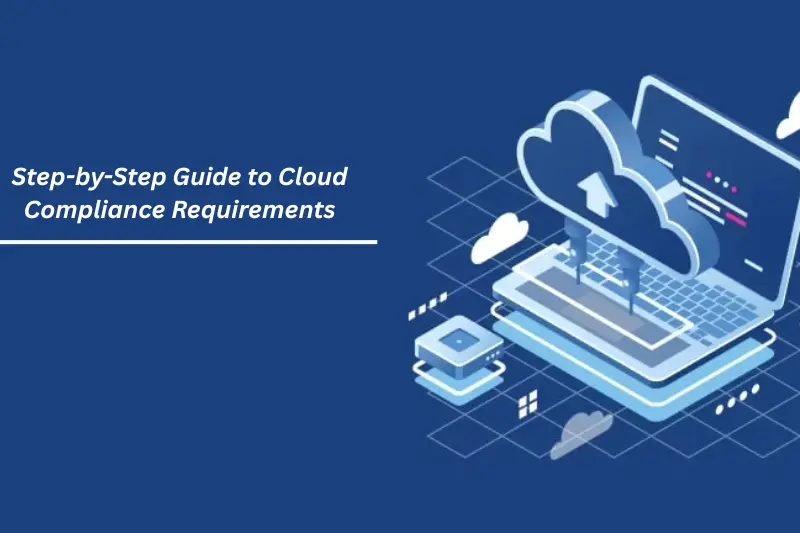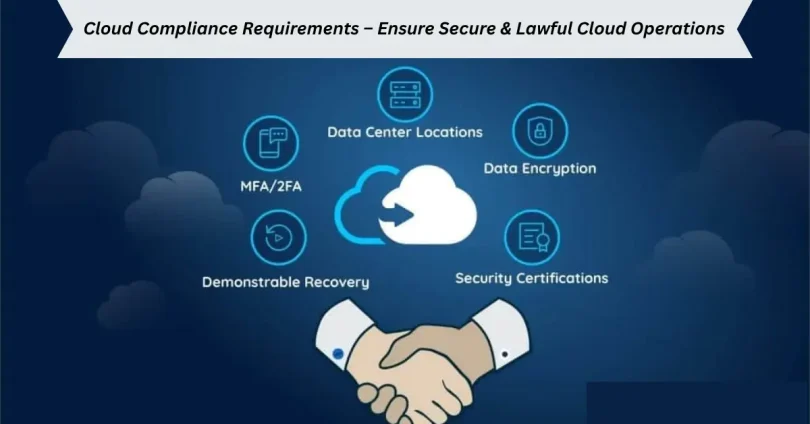Introduction
As more businesses move their data and operations to the cloud, staying compliant with rules and regulations has become more important than ever. Cloud Compliance Requirements – Ensure Secure & Lawful Cloud Operations is not just a technical task—it’s a vital step to protect your business, your customers, and your reputation. From data privacy laws to industry standards, companies must follow specific guidelines to make sure they are using the cloud in a safe and legal way. In this blog, we’ll break down what cloud compliance means, why it matters in 2025, and how you can meet these requirements with confidence.
What is “Cloud Compliance Requirements – Ensure Secure & Lawful Cloud Operations”?

Cloud compliance requirements are the rules and standards businesses must follow when storing and managing data in the cloud. These rules are designed to keep data safe, private, and properly handled according to local and global laws.
“Cloud Compliance Requirements – Ensure Secure & Lawful Cloud Operations” means making sure that your cloud systems follow all legal, regulatory, and industry-specific rules—such as GDPR, HIPAA, ISO 27001, and others. It involves using the right security tools, managing who has access to data, keeping track of where your data is stored, and regularly checking for any risks or gaps.
In simple terms, it’s about using the cloud in a way that is both secure and legal, so your business avoids fines, protects customer trust, and operates with peace of mind.
Why Cloud Compliance Requirements Are Important
Understanding the importance of Cloud Compliance Requirements – Ensure Secure & Lawful Cloud Operations helps businesses stay secure, legal, and trusted in the digital age. Here’s why it matters:
Avoid Legal Penalties and Fines
- Non-compliance can result in heavy fines
Regulatory bodies can impose significant penalties if your cloud systems don’t meet legal standards. These fines can damage your finances and reputation. - Protects against lawsuits
Mishandling data may lead to lawsuits from customers, partners, or regulators. Compliance reduces legal risks and liabilities. - Helps you meet international standards
Following global laws like GDPR or HIPAA ensures smooth operation across borders. This keeps your cloud services legal and accepted worldwide.
Builds Trust with Customers and Stakeholders
- Shows that you care about data protection
When customers know their data is handled properly, they feel safe. This boosts loyalty and long-term relationships. - Strengthens your brand image
A business that takes compliance seriously appears responsible and trustworthy. This gives you a competitive advantage in the market. - Improves investor and partner confidence
Investors and business partners prefer to work with compliant companies. It shows you’re managing risk properly and responsibly.
Enhances Overall Security
- Reduces chances of data breaches
Compliance requires strong security measures, such as encryption and access control. This protects your cloud data from hackers and leaks. - Supports regular audits and monitoring
Regular compliance checks help detect and fix issues early. This keeps your system safe and up to date. - Promotes security best practices
Compliance pushes your team to follow proven safety steps. This creates a more secure and stable cloud environment.
Step-by-Step Guide to Cloud Compliance Requirements

Follow these steps to ensure your cloud operations stay secure, legal, and fully compliant in 2025:
Step 1: Identify Applicable Regulations
- Understand which laws and standards apply to your business.
These could include GDPR (EU), HIPAA (US healthcare), PCI DSS (payment), or ISO/IEC 27001 (global security). - Check your industry and location.
Different sectors and regions have different compliance rules—make sure you’re covered on all fronts.
Step 2: Choose a Compliant Cloud Provider
- Work with providers that meet global compliance standards.
Look for certifications like ISO, SOC 2, HIPAA, and FedRAMP. - Review their shared responsibility model.
Understand which compliance tasks are yours vs. the provider’s.
Step 3: Classify and Protect Your Data
- Identify what data is sensitive or regulated.
Know where your data is stored, how it’s used, and who can access it. - Apply proper data protection measures.
Use encryption, masking, and strong access control for critical information.
Step 4: Set Up Identity & Access Management (IAM)
- Limit access based on user roles and responsibilities.
Implement role-based access control (RBAC) to prevent unauthorized use. - Use multi-factor authentication (MFA).
Add an extra layer of login security to reduce the risk of data breaches.
Step 5: Implement Security & Monitoring Tools
- Use tools to monitor cloud activity in real time.
This helps detect unusual behavior or possible security threats. - Enable logging and audit trails.
Keep records of who accessed what and when, for compliance reviews and investigations.
Step 6: Train Your Team
- Educate employees on data privacy and compliance rules.
Everyone should know how to handle data securely in the cloud. - Run regular awareness sessions and drills.
This helps your team stay updated on best practices and policy changes.
Step 7: Conduct Regular Audits & Reviews
- Schedule regular compliance checks.
Identify gaps, fix issues early, and stay ahead of changes in laws. - Update policies and procedures as needed.
Compliance is ongoing—keep your practices current with new threats and regulations.
Advantages and Disadvantages of Cloud Compliance Requirements
| Advantages | Disadvantages |
| Improved Data Security Compliance requires strong security measures like encryption and access control, which help protect sensitive data from breaches. | Can Be Complex and Time-Consuming Understanding and applying various regulations across regions and industries takes effort and expert knowledge. |
| Avoids Legal and Financial Penalties Following regulations keeps your business safe from fines, lawsuits, and other legal issues. | Higher Costs for Compliance Tools & Audits Implementing security solutions, training staff, and conducting audits may increase operational expenses. |
| Builds Customer Trust When customers know their data is handled responsibly, it increases confidence and loyalty toward your brand. | Constantly Changing Regulations Compliance rules evolve often, so businesses must stay updated and adjust their processes regularly. |
| Supports Global Business Expansion Meeting international compliance standards (like GDPR or ISO) allows you to operate legally across countries. | Requires Continuous Monitoring Compliance isn’t a one-time task—it involves ongoing monitoring, reporting, and maintenance. |
| Encourages Operational Transparency Regular audits and clear documentation improve internal processes and promote accountability. | Responsibility is Shared in the Cloud It can be confusing to know what you’re responsible for versus what the cloud provider handles, which may lead to gaps. |
Common FAQs – Cloud Compliance Requirements
Q1: What is cloud compliance in simple words?
Cloud compliance means following rules and laws when you store and use data in the cloud. It helps keep your data safe and legal.
Q2: Why is cloud compliance important for my business?
It protects you from fines, builds customer trust, and keeps your data secure. It also helps you follow the law and grow your business safely.
Q3: Who is responsible for cloud compliance—me or my cloud provider?
Both of you share the responsibility. The cloud provider handles some parts (like server security), and you manage things like data access and user permissions.
Q4: What laws do I need to follow for cloud compliance?
It depends on your business type and location. Common ones include GDPR (EU), HIPAA (healthcare), PCI DSS (payment data), and ISO 27001.
Q5: How do I know if my cloud provider is compliant?
Check if they have certifications like ISO, SOC 2, or HIPAA. Most providers list this information on their websites or trust centers.
Q6: Do I need special tools for cloud compliance?
Yes, tools for encryption, access control, monitoring, and audits can help. Many cloud platforms also offer built-in compliance features.
Q7: How often should I review my compliance status?
You should check it regularly—at least once a quarter or whenever laws or your cloud setup changes.
Q8: What happens if I don’t follow cloud compliance rules?
You could face fines, lose customer trust, or even get banned from certain markets. It’s always better to stay safe and compliant.
Conclusion
Cloud compliance is all about keeping your data safe and following the rules. By meeting Cloud Compliance Requirements – Ensure Secure & Lawful Cloud Operations, your business avoids risks, builds trust, and stays legally protected. In today’s digital world, staying compliant is not just smart—it’s necessary for secure and successful cloud operations.
Bonus Points
- Use Cloud Provider Compliance Tools
Most top cloud platforms (like AWS, Azure, Google Cloud) offer built-in tools and dashboards to help you stay compliant—use them! - Automate Compliance Checks
Save time and reduce errors by using automated tools to monitor, report, and alert on compliance issues in real-time. - Keep Backup & Recovery Plans Ready
Always have secure backups and disaster recovery plans in place. This not only helps in emergencies but is often a compliance requirement. - Involve Legal and IT Teams Together
Make sure both your legal and tech teams work closely. Compliance isn’t just about tech—it’s also about understanding the laws. - Regularly Update Your Policies
As laws and technologies change, your cloud compliance policies should too. Keep them fresh and relevant.




